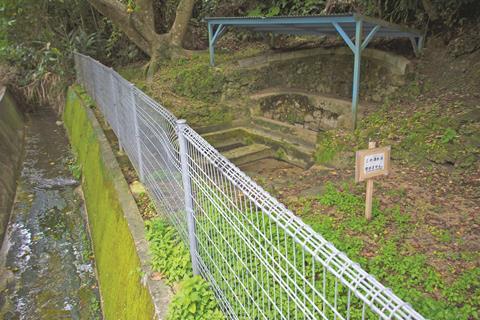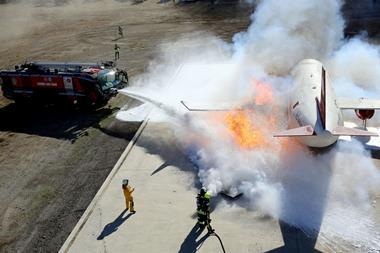
Pollution that has contaminated waterways on the Japanese island of Okinawa almost certainly came from two US air bases and is stoking diplomatic tensions between Japan and America. The suspected source of the pollutants are firefighting foams containing per- and polyfluoroalkyl substances (PFASs) that have long been used for training exercises at facilities like the US Kadena Air Base and Marine Corps Air Station Futenma on Okinawa.
PFAS compounds – including perfluorooctanesulfonate (PFOS), perfluorooctanoic acid (PFOA) and perfluorohexanesulfonic acid (PFHxS) – have been detected around the two air bases, according to Masami Kawamura, who directs the Informed Public Project, an Okinawa-based research organisation that focuses on environmental issues. Surveys conducted by the island’s local government indicate that it is ‘highly likely’ that the two US bases caused this PFAS contamination, she wrote in a 12 May letter to members of the US House of Representatives energy and commerce committee’s environment subcommittee.
The headquarters of the US military in Japan was asked for comment but did not respond.
Accusations that the two bases have contaminated Okinawa’s environment have grown in recent weeks. Ahead of President Donald Trump’s recent visit to Japan, the issue was raised at a parliamentary environmental committee meeting in Tokyo, and Kawamura and her organisation also brought it to the attention of the US Congress.
PFAS exposure is associated with serious health problems, including cancer, reproductive and developmental damage, high cholesterol, immune system dysfunction, as well as liver and kidney damage. These substances are highly persistent in animals and humans, as well as in the environment, and accumulate over time.
Way above US health limits
Okinawa is one of Japan’s smaller islands but hosts over two-thirds of US military bases in the country. An investigation by the Okinawa Times revealed that the US military surveyed the Futenma base in 2016 and detected PFOS at a concentration of 27,000 parts per trillion (ppt) and PFOA at 1800ppt in wastewater samples from a firefighting training site on the base.
The US Environmental Protection Agency has set a lifetime health advisory for drinking water of 70ppt for individual and combined PFOA and PFOS. However, some researchers – including a team from Harvard University – have concluded that PFAS levels at or above 1ppt could be harmful to human health.
Recent analysis by the Okinawa Prefectural Enterprise Bureau (OPEB), the agency responsible for clean drinking water on the island, found over 1124ppt of combined PFOS and PFOA in the Dakujaku River in March 2019, according to Kawamura. That river is fed by water passing through the Kadena base, and runs through Okinawa City.
To address the Dakujaku pollution, OPEB installed a carbon filtration system at the local water treatment plant to remove PFOA and PFOS coming from sources around the US air base, Kawamura said. The agency has incurred costs of almost $1.5 million (£1.2 million), Kawamura estimates.
Meanwhile, high concentrations of PFOS and PFOA have also turned up in natural springs and groundwater on Okinawa. 2100ppt of these two compounds combined were detected in Yara Yara Ubuga, a natural spring in the town of Kadena, Kawamura notes. Last summer, she said, PFOA and PFOS were detected at 2000ppt in the Chunnagaa spring – a cultural and historical site.
Fears grow
The Okinawa Times published an article last month on Kawamura’s research, which revealed that PFAS contamination dates back at least a decade in Okinawa’s capital city Naha, and that it affects residents living far from US military bases. ‘After that, Okinawan people’s fears have grown,’ Kawamura tells Chemistry World.
The US military’s response to the contamination has been inadequate, according to Kawamura. It has not been forthcoming with information about PFAS pollution on the island, and has not allowed either the Okinawan or Japanese authorities to carry out surveys on the bases, she says.
‘Despite the available data, analysis and evidence that points to the US bases as [the] source of PFAS contamination, the US military has [taken] no actions to remedy this problem,’ Kawamura wrote in her letter to members of Congress. ‘Instead, in our view, the military has evaded its responsibility.’
Kawamura is urging Congress to hold the US military accountable and be more open about the extent of the PFAS contamination on Okinawa. She is also calling for the US military to collaborate with the Okinawan government on surveys of PFAS levels on the bases and surrounding areas.
Meanwhile, a study by two Kyoto University professors has found extremely high concentrations of PFOS and PFHxS in the blood of people living around the two air bases. The levels detected in these blood samples were reportedly four times the national average for PFOS and more than 53 times the national average for PFHxS.

















No comments yet